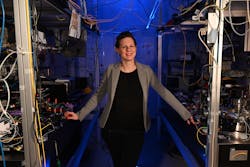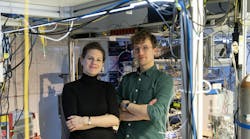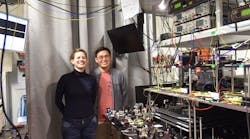Faces in Photonics: Birgit Stiller, Max Planck Institute
Editor's note: Listen to our podcast interview with Birgit Stiller below, which we released on June 17, 2025.
The Faces in Photonics series shines a light on scientists, researchers, leaders, and educators from all over the world whose work is reshaping the optics and photonics industry. This month we are spotlighting Birgit Stiller, who leads the Quantum Optoacoustics Research Group at the Max Planck Institute for the Science of Light.
Laser Focus World: What inspired you to head into the realm of quantum optoacoustics?
Birgit Stiller: I have a background in quantum communications, integrated photonics, and typical nonlinear fiber optics topics. My specialty is the interaction of light with sound waves and this domain between optics and mechanics or acoustics has fascinated me ever since I started my Ph.D. I got inspired to head into the realm of this relatively new topic of quantum optoacoustics because there are still many questions to be answered and I believe that many applications of light-sound interactions can be useful for future quantum technologies.
LFW: Which research areas are you currently exploring/working on?
Stiller: The main focus of my research group is the interaction of optical waves with traveling acoustic waves, which combines two quite different domains in physics. The interaction of both enables a range of applications and fundamental research. We work, for example, on applications of light-sound interactions for signal processing within the classical and quantum domain, on devices for quantum communications, optical memory, and on nonreciprocal schemes based on mechanical waves. We’re interested in exploring different thermodynamic regimes with optoacoustics to see how acoustic waves behave when interacting with optical vortices.
LFW: Most intriguing things you’re seeing going on in quantum work right now?
Stiller: It would almost be a pity to choose only one single intriguing project or experiment. There are exciting results on quantum computing almost every day, as well as secure quantum communications and more fundamental research with no ready applications yet. To name a few: In terms of quantum communications and advanced classical encryption theory, it was very intriguing to see in 2022 that even the most secure classical codes can be subject to being cracked; nonlocal interactions are always most fascinating (and they are still being investigated), the ‘spooky action at a distance’ how Einstein called it; and the race for ‘quantum supremacy’ with different approaches is spectacular to watch.
LFW: Any advice for people who want to get into quantum optoacoustics?
Stiller: As advice to anyone who wants to enter into quantum technologies, in general, I would recommend contacting and joining any of the research groups or companies that are currently interested in developing quantum technologies. The timing is perfect to either get onboard an exciting quantum startup or work on the next cutting-edge experiment in one of the many research groups.
LFW: Favorite thing about your job/work?
Stiller: I really enjoy working with motivated and enthusiastic colleagues. Most projects become a success story when working with collaborators who are easy to work with. Moreover, I like both: if an experiment turns exactly into what we predicted by theory or, in contrast, some new insights or weird measurement results appear that need clarification—it is basically never boring.
Related Articles
About the Author
Sally Cole Johnson
Editor in Chief
Sally Cole Johnson, Laser Focus World’s editor in chief, is a science and technology journalist who specializes in physics and semiconductors.




